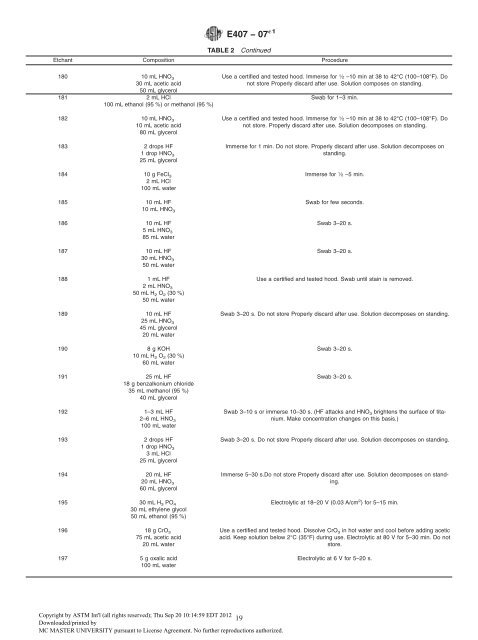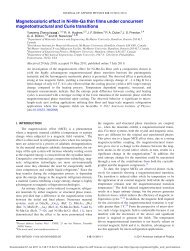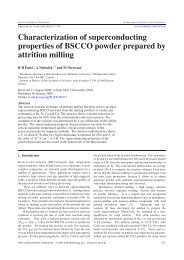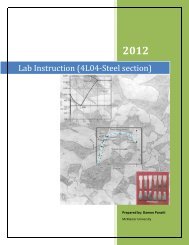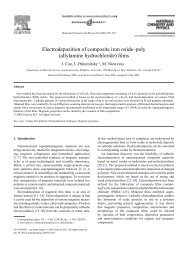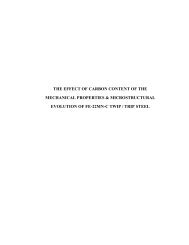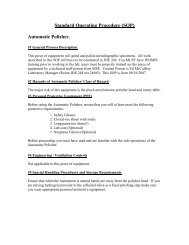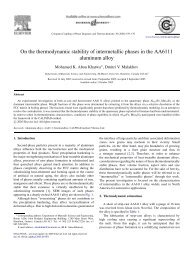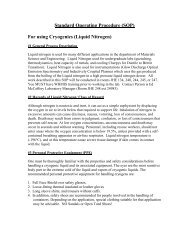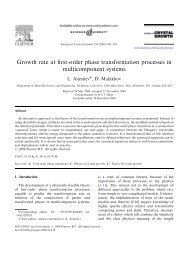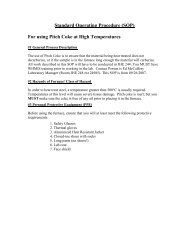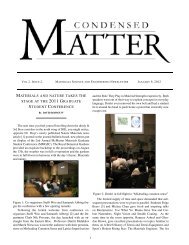E407-07 Microetching Metals and Alloys.pdf - McMaster Department ...
E407-07 Microetching Metals and Alloys.pdf - McMaster Department ...
E407-07 Microetching Metals and Alloys.pdf - McMaster Department ...
Create successful ePaper yourself
Turn your PDF publications into a flip-book with our unique Google optimized e-Paper software.
TABLE 2 Continued<br />
Etchant Composition Procedure<br />
180 10 mL HNO3 30 mL acetic acid<br />
50 mL glycerol<br />
181 2 mL HCl<br />
100 mL ethanol (95 %) or methanol (95 %)<br />
182 10 mL HNO 3<br />
10 mL acetic acid<br />
80 mL glycerol<br />
183 2 drops HF<br />
1dropHNO 3<br />
25 mL glycerol<br />
184 10 g FeCl 3<br />
2 mL HCl<br />
100 mL water<br />
185 10 mL HF<br />
10 mL HNO 3<br />
186 10 mL HF<br />
5 mL HNO 3<br />
85 mL water<br />
187 10 mL HF<br />
30 mL HNO 3<br />
50 mL water<br />
188 1 mL HF<br />
2 mL HNO 3<br />
50 mL H 2 O 2 (30 %)<br />
50 mL water<br />
189 10 mL HF<br />
25 mL HNO 3<br />
45 mL glycerol<br />
20 mL water<br />
190 8 g KOH<br />
10 mL H 2 O 2 (30 %)<br />
60 mL water<br />
Use a certified <strong>and</strong> tested hood. Immerse for 1 ⁄2 –10 min at 38 to 42°C (100–108°F). Do<br />
not store Properly discard after use. Solution composes on st<strong>and</strong>ing.<br />
Swab for 1–3 min.<br />
Use a certified <strong>and</strong> tested hood. Immerse for 1 ⁄2 –10 min at 38 to 42°C (100–108°F). Do<br />
not store. Properly discard after use. Solution decomposes on st<strong>and</strong>ing.<br />
Immerse for 1 min. Do not store. Properly discard after use. Solution decomposes on<br />
st<strong>and</strong>ing.<br />
Immerse for 1 ⁄2 –5 min.<br />
Swab for few seconds.<br />
Swab 3–20 s.<br />
Swab 3–20 s.<br />
Use a certified <strong>and</strong> tested hood. Swab until stain is removed.<br />
Swab 3–20 s. Do not store Properly discard after use. Solution decomposes on st<strong>and</strong>ing.<br />
Swab 3–20 s.<br />
191 25 mL HF Swab 3–20 s.<br />
18 g benzalkonium chloride<br />
35 mL methanol (95 %)<br />
40 mL glycerol<br />
192 1–3 mL HF<br />
2–6 mL HNO 3<br />
100 mL water<br />
193 2 drops HF<br />
1dropHNO 3<br />
3 mL HCl<br />
25 mL glycerol<br />
194 20 mL HF<br />
20 mL HNO 3<br />
60 mL glycerol<br />
195 30 mL H 3 PO 4<br />
30 mL ethylene glycol<br />
50 mL ethanol (95 %)<br />
196 18 g CrO 3<br />
75 mL acetic acid<br />
20 mL water<br />
197 5 g oxalic acid<br />
100 mL water<br />
<strong>E4<strong>07</strong></strong> − <strong>07</strong> ´1<br />
Copyright by ASTM Int'l (all rights reserved); Thu Sep 20 10:14:59 EDT 2012<br />
19<br />
Downloaded/printed by<br />
MC MASTER UNIVERSITY pursuant to License Agreement. No further reproductions authorized.<br />
Swab 3–10 s or immerse 10–30 s. (HF attacks <strong>and</strong> HNO 3 brightens the surface of titanium.<br />
Make concentration changes on this basis.)<br />
Swab 3–20 s. Do not store Properly discard after use. Solution decomposes on st<strong>and</strong>ing.<br />
Immerse 5–30 s.Do not store Properly discard after use. Solution decomposes on st<strong>and</strong>ing.<br />
Electrolytic at 18–20 V (0.03 A/cm 2 ) for 5–15 min.<br />
Use a certified <strong>and</strong> tested hood. Dissolve CrO 3 in hot water <strong>and</strong> cool before adding acetic<br />
acid. Keep solution below 2°C (35°F) during use. Electrolytic at 80 V for 5–30 min. Do not<br />
store.<br />
Electrolytic at 6 V for 5–20 s.


